As part of the recent battery technology briefing at the General Motors Technical Center, the attendees were taken on a tour of the hybrid battery test lab. Our group was taken through by lab manager Doug Drauch, who gave us an overview of the activities that take place in the lab. GM has four phases of battery testing with the first phase focusing on individual cells and their performance. In phase two testing, they evaluate the performance and behavior of strings of cells tied together but not fully assembled into a pack.
In phase three, they test fully assembled battery packs, and phase four is system integration testing. The lab we went through focuses on phase two and three with some limited phase four testing. The lab that does the phase one testing is in another building on the Tech Center campus. Continue on after the jump for more on the lab tour and what goes on there.
Related:
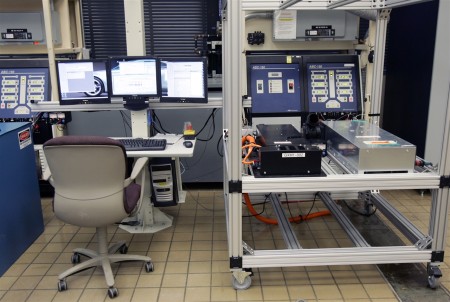
The first station we saw was a 125kW battery cycler that had two of the nickel metal hydride battery packs for the upcoming Two-Mode hybrid Tahoe/Yukon hooked up. As Doug explained it, the cycler is computer controlled and is used much like a dynamometer would be used for testing engines. For this particular set up the complete battery packs were sitting on an open rack and being driven through the kind of usage cycles that they might see in a vehicle on the road.
The cycler allows for automating the process of putting a load on the battery pack to drain and then recharge the pack. This allows the engineers to both monitor the health of the pack and evaluate the control software for the pack that will be used in the vehicle. They can easily run it through tens of thousands of cycles replicating what would happen over the lifespan of a vehicle. The hybrid control system can then be modified to optimize both the performance of the vehicle and maximize the useful life of the pack. Because of the power requirements of that cycler, it has to be hard wired into the electrical circuitry of the lab and can't be readily moved.
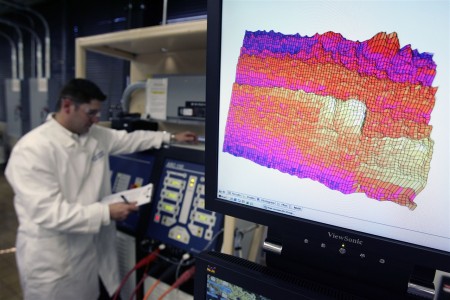
Another station with a similar cycler was also running nearby with an open case Two-Mode battery pack. This one was also on an open rack but had a thermal imaging camera situated above it. This was used to monitor the temperature profile across the pack the pack as it was being cycled and look for hot spots. Again this allows the engineers to monitor the behavior of the pack during various usage patterns and modify the control software in order to maximize the health and lifespan of the pack.
In addition to the fixed cyclers, they also had some smaller units that can be plugged into outlets in the wall. This allows them to be moved around to different parts of the lab to be used for different tests such as the thermal chambers.
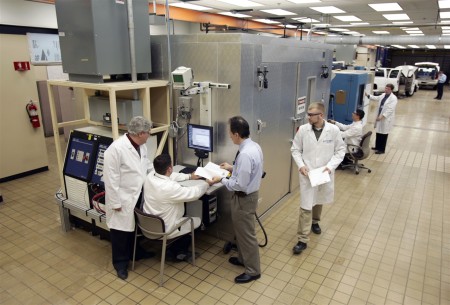
In the center of the lab was a large thermal chamber, that allows the engineers to install several battery packs and then automatically run them through four season tests, again to simulate various vehicle usage patterns. The batteries get run temperatures as low as -40F up to 120F for thousands of cycles.
Across the aisle from the thermal chamber are what are referred to as the coffins. In these chambers, they run the life tests where the battery packs are essentially run to destruction. They are continuously cycled in accelerated tests until they can no longer hold a charge.
-of-gmbatterylab01.jpg)
The lab also has room to bring in full vehicles where the battery packs can be installed, and hooked up to the full vehicle system. The portable cyclers can then be hooked up to the vehicle wiring harness and the batteries can be tested as part of an integrated system. This allows the engineers to compare the results against the bench tests and determine if there are other weak spots in the vehicle, such as wiring and electrical interconnects or ventilation of the pack chamber that may need to be modified.
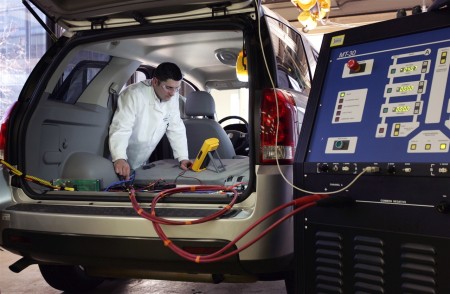
Finally we saw what Doug called the graveyard. This was a rack of old battery packs that had outlived their usefulness. We saw the evolution of the battery pack for the previous Parallel Hybrid Truck Silverado that is now out of production. The packs on display were not all tested to destruction, they had just become obsolete during the course of development. The oldest pack had a clearly hand made case and a lot of fasteners to hook up the electrical connections between the cells as well as the ventilation. Through the series of packs it gradually evolved to stamped and welded cases, fewer connections and more moulded plastic ductwork on the final production version. The Two-Mode packs that we saw running in the lab were all in essentially production configuration as the Two-Mode Tahoe and Yukon are scheduled to go into production later this fall.
In phase three, they test fully assembled battery packs, and phase four is system integration testing. The lab we went through focuses on phase two and three with some limited phase four testing. The lab that does the phase one testing is in another building on the Tech Center campus. Continue on after the jump for more on the lab tour and what goes on there.
Related:
- General Motors invites us behind the curtain: battery development..
- Editorial: Why the carmakers seem to be dragging their feet on ba...

The first station we saw was a 125kW battery cycler that had two of the nickel metal hydride battery packs for the upcoming Two-Mode hybrid Tahoe/Yukon hooked up. As Doug explained it, the cycler is computer controlled and is used much like a dynamometer would be used for testing engines. For this particular set up the complete battery packs were sitting on an open rack and being driven through the kind of usage cycles that they might see in a vehicle on the road.
The cycler allows for automating the process of putting a load on the battery pack to drain and then recharge the pack. This allows the engineers to both monitor the health of the pack and evaluate the control software for the pack that will be used in the vehicle. They can easily run it through tens of thousands of cycles replicating what would happen over the lifespan of a vehicle. The hybrid control system can then be modified to optimize both the performance of the vehicle and maximize the useful life of the pack. Because of the power requirements of that cycler, it has to be hard wired into the electrical circuitry of the lab and can't be readily moved.

Another station with a similar cycler was also running nearby with an open case Two-Mode battery pack. This one was also on an open rack but had a thermal imaging camera situated above it. This was used to monitor the temperature profile across the pack the pack as it was being cycled and look for hot spots. Again this allows the engineers to monitor the behavior of the pack during various usage patterns and modify the control software in order to maximize the health and lifespan of the pack.
In addition to the fixed cyclers, they also had some smaller units that can be plugged into outlets in the wall. This allows them to be moved around to different parts of the lab to be used for different tests such as the thermal chambers.

In the center of the lab was a large thermal chamber, that allows the engineers to install several battery packs and then automatically run them through four season tests, again to simulate various vehicle usage patterns. The batteries get run temperatures as low as -40F up to 120F for thousands of cycles.
Across the aisle from the thermal chamber are what are referred to as the coffins. In these chambers, they run the life tests where the battery packs are essentially run to destruction. They are continuously cycled in accelerated tests until they can no longer hold a charge.
-of-gmbatterylab01.jpg)
The lab also has room to bring in full vehicles where the battery packs can be installed, and hooked up to the full vehicle system. The portable cyclers can then be hooked up to the vehicle wiring harness and the batteries can be tested as part of an integrated system. This allows the engineers to compare the results against the bench tests and determine if there are other weak spots in the vehicle, such as wiring and electrical interconnects or ventilation of the pack chamber that may need to be modified.

Finally we saw what Doug called the graveyard. This was a rack of old battery packs that had outlived their usefulness. We saw the evolution of the battery pack for the previous Parallel Hybrid Truck Silverado that is now out of production. The packs on display were not all tested to destruction, they had just become obsolete during the course of development. The oldest pack had a clearly hand made case and a lot of fasteners to hook up the electrical connections between the cells as well as the ventilation. Through the series of packs it gradually evolved to stamped and welded cases, fewer connections and more moulded plastic ductwork on the final production version. The Two-Mode packs that we saw running in the lab were all in essentially production configuration as the Two-Mode Tahoe and Yukon are scheduled to go into production later this fall.
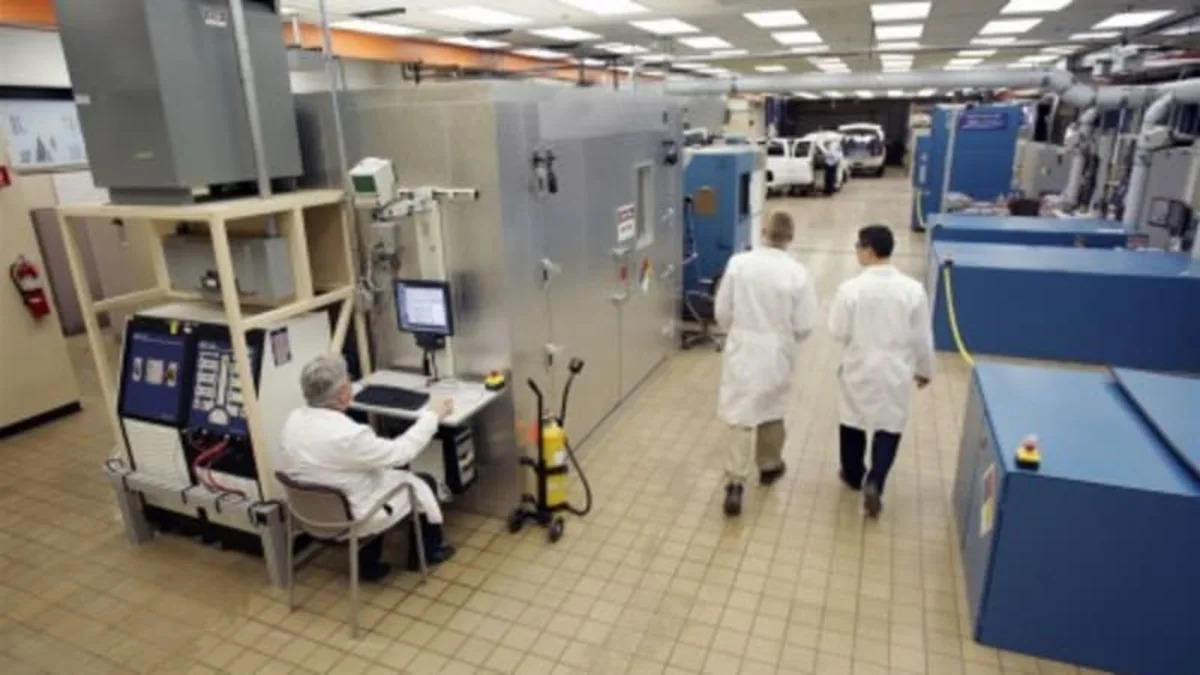

Sign in to post
Please sign in to leave a comment.
Continue